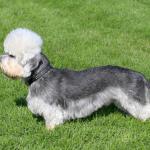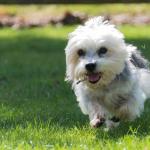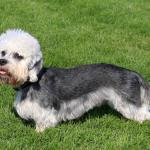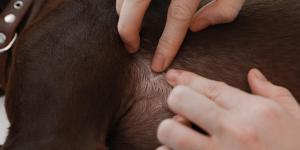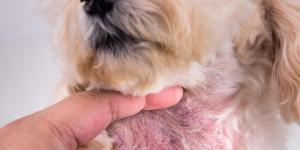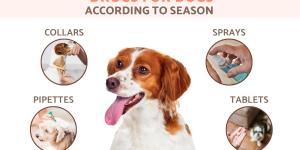Dandie Dinmont Terrier

Dandie Dinmont Terriers are cute, small and friendly dogs. They're part of the Terrier family as they are a mix from the Bedlington Terrier and Skye Terrier. If you're thinking of adopting one of these dogs, you've come to the perfect place!
In this AnimalWised breed sheet, we're going to tell you everything you need to know about the Dandie Dinmont Terrier breed and how to care for them!
- Europe
- United Kingdom
- Group III
- 5-14
- 14-18
- 18-22
- 22-27
- 27-31
- More than 31
- 2-7
- 7-22
- 22-55
- 55-100
- 100-220
- 8-10
- 10-12
- 12-14
- 15-20
- Low
- Meidum
- High
Origin of the Dandie Dinmont Terrier
The Dandie Dinmont Terrier is a very old dog breed dating back to the 18th century. The first Dandie Dinmont Terrier puppies were born on the border between England and Scotland. This breed comes from crosses between the Bedlington Terrier , the Skye Terrier and the now-defunct Scottish terrier.
This breed used to be popular among farmers thanks to their abilities to kill vermin that caused them economic losses, also for its skills as a hunter of otters and badgers. In the year 1814, this breed had an appearance in the book Guy Mannering by the author Sir Walter Scott. This made them become popular by the general population, not just farmers. In the year, 1875, the Dandie Dinmont Terrier Club was created and the breed was finally recognized by the Kennel Club.
Characteristics of the Dandie Dinmont Terrier
The Dandie Dinmont Terrier is a small dog, weighing between 8 and 11 kilograms with a height at the withers is 20 to 28 centimeters. The life expectancy of these dogs is between 12 and 15 years approximately.
The body is elongated, with rounded shapes and flexible limbs. Their back is low and curved and their legs are short and muscular. Their tail is also short. It's thicker at the base than at the tip and it is always straight. The head of this breed is large, but proportionate to the rest of the body, they have strong jaws, highly developed musculature. It is wider at the back and tapers in the eye area. The entire head is covered with hair. Their eyes are large, bright and round, of a very intense hazel color. Their ears are set low, hanging and distant from each other.
Despite all the above, if something stands out among all the characteristics of the Dandie Dinmont Terrier, it is their hair. The coat of the Dandie Dinmont Terrier is made up of a two-layered coat, a woolly lower one that serves as insulation and protection and a harder outer coat that is somewhat rough to the touch. The hair is distributed in the form of tassels, being longer in the forelimbs, where it forms fringes of about 5 cm in length. The accepted colors are pepper or mustard. In both cases the tone is lighter in the fringes of the front legs, the same as that of the lower part of the tail, which forms another fringe of longer and softer hair.
Character of the Dandie Dinmont Terrier
Dandie Dinmont Terriers are truly determined dogs, exhibiting a marked independent character. They are incredibly brave and sometimes even reckless. They also need a lot of attention as they enjoy company and especially affection from their human companions. These dogs are very loving and intelligent, making it easy and enjoyable to train them.
They adapt well to small spaces, such as an apartment in the city, and even larger places, such as a farm. They adapt well to all families, whether it is with children, the elderly or a single loving companion. These dogs are a great choice!
How to care for a Dandie Dinmont Terrier
When caring for a Dandie Dinmont Terrier we need to pay close attention to their coat as they have two layers of hair. Therefore, we need to brush it frequently to avoid tangling and the accumulation of dirt. It's recommended to brush their coat once a day. As for baths, it's recommended to bathe them once a month, using special shampoo made for their type of hair. Thankfully, these dogs don't shed a lot of hair. With daily brushings, you shouldn't worry about their hair.
Other than their coat care, these dogs will need a high quality canine diet, lots of attention and affection, daily exercise and good training. You must also keep up with their vaccination and deworming schedule, as with all dogs. Doing these things, your dog will live a happy and healthy life with you.
Dandie Dinmont Terrier training
Dandie Dinmont Terriers are smart dogs, making their training easy and enjoyable. In fact, thanks to their intelligence and great attention span, these dogs are also trained to become therapy dogs for different types of patients, such as children with autism, people with cerebral palsy, etc.
These dogs, like any other dog, thrive on training through positive reinforcement. You should never scold your dog or be physically or verbally violent towards them. Train them through positive reinforcement so they have a good experience training with you. This will also help both of you have a greater bond.
When your Dandie Dinmont Terrier is a puppy, you should socialize them so they become familiar with other people, dogs and places. This will also help them have a more balanced temperament when they're adults.
You can also read our article on basic dog training, so you can teach your Dandie Dinmont Terrier basic commands that can keep them safe in certain situations.
Dandie Dinmont Terrier health
Dandie Dinmont Terriers are prone to certain diseases, such as:
- Cushing's syndrome: where there is an alteration of the adrenal glands which affects the production of the hormone cortisol. This leads to obesity, hypertension, skin conditions and osteoporosis, as well as some mental disorders. Learn more in our article about cushing's syndrome in dogs.
- Hypothyroidism: which leads to insufficient production of thyroid hormone. Symptoms include weight gain. Learn more in our article about hypothyroidism in dogs.
- Glaucoma: is an eye disorder which can lead to blindness. Learn more in our article about glaucoma in dogs.
Therefore, it is vital to take your Dandie Dinmont Terrier to regular check-ups with their veterinarian. Early detection in any of the diseases mentioned here, or not mentioned here, can always help find the correct treatment before the disease or illness becomes too advanced.
Dandie Dinmont Terrier photos

